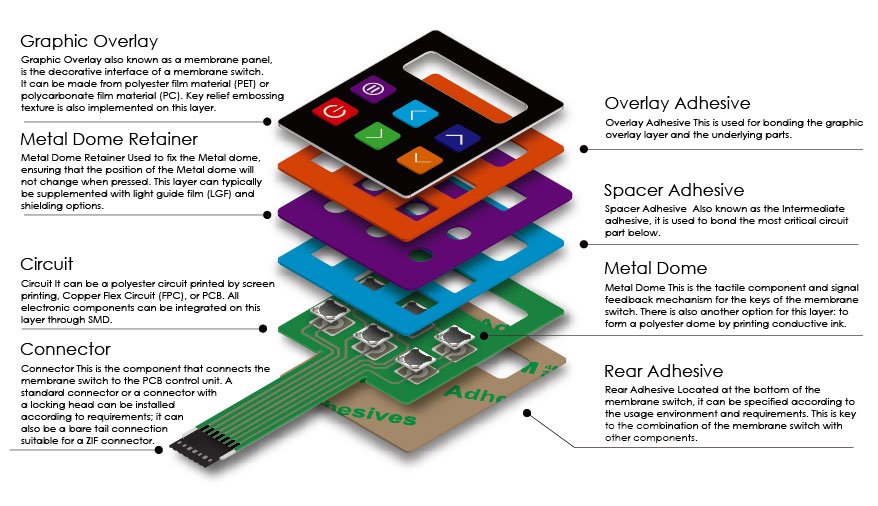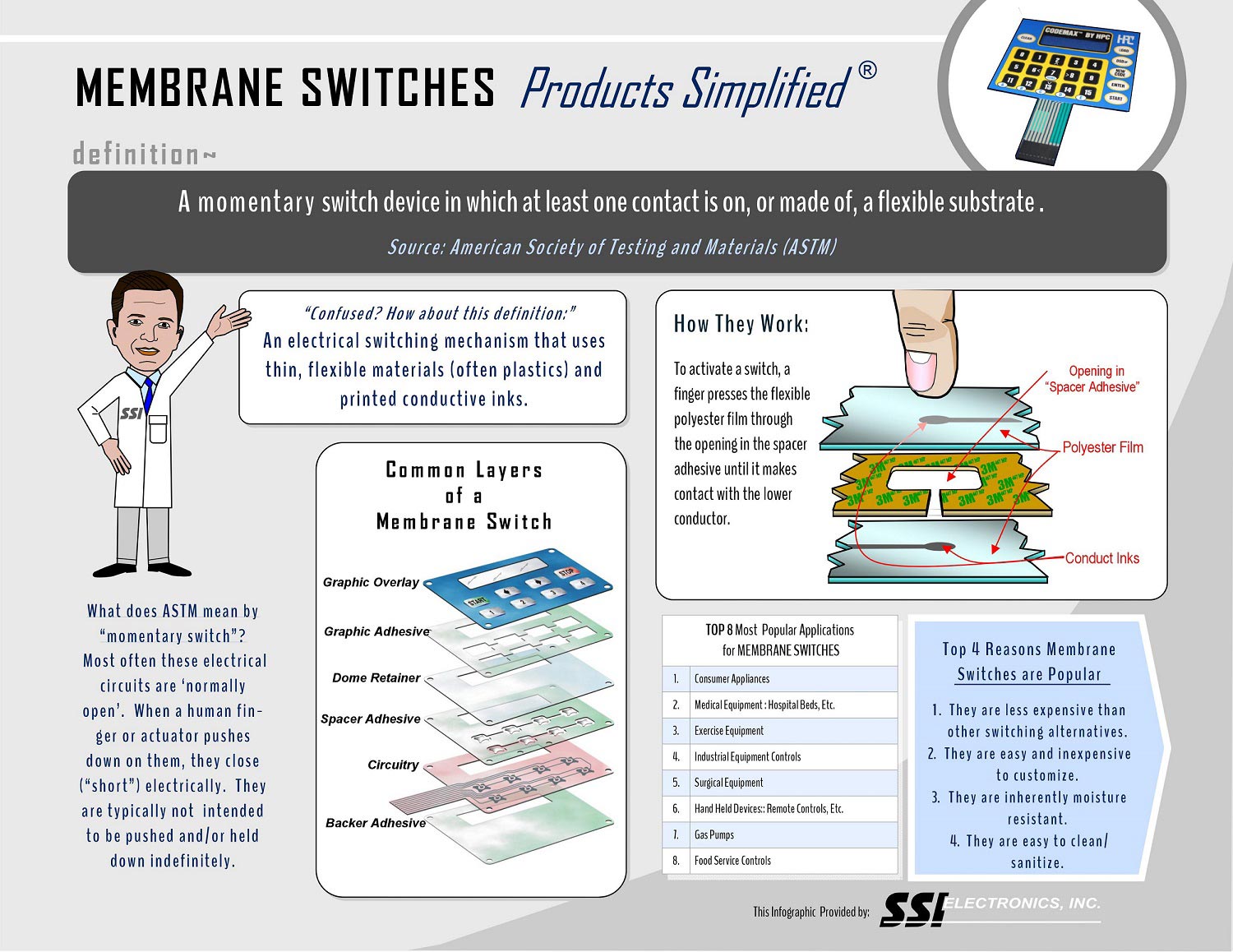Recognizing the Importance of Membrane Layer Switch in Modern Electronic Devices
Membrane switches are essential elements in contemporary digital devices. They provide a mix of performance and design that boosts customer interaction. Their lightweight and long lasting nature makes them ideal for various applications. As markets develop, the demand for personalization and advanced functions grows. Understanding how membrane switches over add to advancement reveals their relevance in shaping the future of electronics. What exists in advance for this modern technology?
The Basics of Membrane Switch Innovation
Although typically neglected, membrane layer switch modern technology plays a necessary role in the modern-day electronics landscape - membrane switch. These gadgets, composed of several layers, work as interface for different digital items, varying from family appliances to clinical devices. A regular membrane switch consists of a visuals overlay, a spacer layer, and a circuit layer, which are diligently set up to develop a practical interface.When stress is related to the overlay, the circuit layer is completed, allowing signals to be transmitted to the gadget. This technology is recognized for its adaptability, making it possible for modification in shape, functionality, and layout to meet particular individual demands. Additionally, membrane switches are slim and light-weight, making them appropriate for applications where area is a premium. Their longevity and resistance to ecological factors further enhance their appeal, ensuring they can endure rough problems while keeping capability. Overall, membrane layer switch innovation is important to producing efficient and easy to use digital gadgets

Trick Advantages of Membrane Layer Changes
Membrane layer switches over offer numerous key benefits that make them a favored choice in various electronic applications. Their layout permits a compact form aspect, allowing suppliers to develop smooth and lightweight tools. Additionally, membrane switches are resistant to dirt, moisture, and chemicals, which improves their sturdiness and longevity in requiring settings. The tactile feedback supplied by these buttons can enhance individual experience, making them very easy and user-friendly to operate.Furthermore, membrane layer switches can be personalized with diverse graphics and shades, permitting one-of-a-kind branding opportunities. The production procedure is usually economical, especially for high-volume production, as it minimizes setting up time and streamlines layout. Membrane layer switches over require minimal maintenance, contributing to reduced general functional prices. These advantages underscore their growing appeal in modern electronics, where integrity and user-friendly interfaces are important.

Applications Across Different Industries
The flexibility of membrane switches enables their widespread adoption across different markets. In the medical area, they are generally made use of in analysis devices and client monitoring systems, providing a durable interface resistant to pollutants. The auto sector uses membrane layer buttons for dashboard controls, improving customer experience with smooth layouts that stand up to rough problems. In customer electronic devices, they function as control board for devices such as microwaves and coffee manufacturers, giving an user-friendly interface that is simple to tidy. The aerospace industry utilizes membrane layer switches in cabin controls, where integrity and area effectiveness are paramount. Additionally, the industrial field leverages these switches in machinery and control systems to assure robust operation in demanding environments. This broad range of applications highlights the flexibility of membrane layer buttons, making them indispensable parts in enhancing functionality and customer communication throughout diverse technological landscapes.
Modification and Layout Flexibility

Future Patterns in Membrane Layer Change Growth
Emerging fads in membrane switch advancement suggest an expanding focus on boosted performance and combination with smart modern technologies. As customer demand for a lot more innovative electronic devices boosts, suppliers are concentrating on producing membrane switches that not only offer fundamental operational functions however likewise integrate attributes like touch level of sensitivity, backlighting, and haptic feedback.Furthermore, developments in products are anticipated webpage to improve durability and ecological resistance, making membrane changes suitable for diverse applications in sectors such as health care, auto, and customer electronics. The integration of capacitive touch innovation is likely to end up being extra common, permitting sleeker layouts and enhanced user interfaces. membrane switch.Additionally, the surge of the Internet of Points (IoT) is motivating the growth of membrane layer changes that can connect wirelessly with other tools, enhancing interconnectivity. Overall, the future of membrane layer button innovation appears appealing, driven by development and the search of user-friendly services
Frequently Asked Concerns
How Do Membrane Layer Switches Over Contrast to Standard Mechanical Switches?
Membrane switches, being extra space-efficient and offering a streamlined layout, comparison with conventional mechanical buttons that provide responsive feedback. The previous commonly include adjustable graphics, while the last usually assure durability and integrity in different applications.
What Products Are Commonly Made Use Of in Membrane Switch Manufacturing?
Membrane layer buttons are normally created making use of materials such as polyester, polycarbonate, and published conductive inks. These materials supply responsiveness, resilience, and flexibility, making them ideal for various applications in digital gadgets and interface.
Can Membrane Switches Be Repaired or Reused?
Membrane buttons can usually be repaired, specifically if minor issues emerge, such as sticky failing or surface area damage. Nonetheless, total reuse is normally limited due to use and possible deterioration of materials over time.
Exactly How Do Ecological Factors Impact Membrane Change Efficiency?
Ecological aspects, such as moisture, direct exposure, and temperature level to chemicals, considerably affect membrane layer button efficiency. Severe problems can bring about deterioration, affecting responsiveness and durability, eventually jeopardizing the performance of the tool in different applications.
What Is the Regular Lifespan of a Membrane Switch over?
The common life expectancy of a membrane switch usually ranges from 1 to 5 million actuations, depending upon variables my website such as usage frequency, environmental problems, and the materials used in manufacturing, influencing durability and performance long life. A regular membrane button is composed of a graphic overlay, a spacer layer, and a circuit layer, which are carefully put together to create a functional interface - membrane switch.When pressure is applied to the overlay, the circuit layer is completed, permitting signals to be transferred to the device. The responsive comments offered by these buttons can boost user experience, making them very easy and instinctive to operate.Furthermore, membrane buttons can be personalized with varied graphics and colors, allowing for distinct branding possibilities. As consumer need for more sophisticated electronic tools rises, producers are focusing on producing membrane switches that not only offer standard operational functions yet also include functions like touch sensitivity, backlighting, and haptic feedback.Furthermore, improvements in materials are anticipated to enhance resilience and ecological resistance, making membrane layer changes suitable for diverse applications in markets such as health care, auto, and consumer electronics. The combination of capacitive touch technology is likely to come to be extra widespread, enabling for sleeker styles and boosted customer interfaces.Additionally, the surge of the Net of Things (IoT) is motivating the advancement of membrane changes that can communicate wirelessly with other gadgets, improving interconnectivity. Membrane buttons, being extra space-efficient and supplying a streamlined layout, contrast with standard mechanical buttons that give responsive feedback